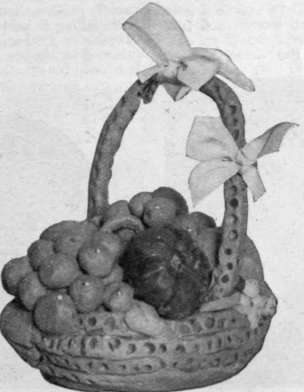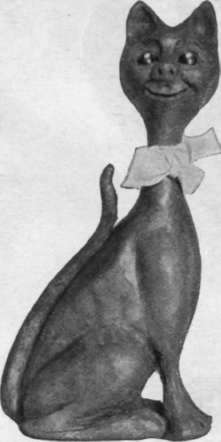Simple, Modelling
Description
This section is from "Every Woman's Encyclopaedia". Also available from Amazon: Every Woman's Encyclopaedia.
Simple, Modelling
An Artistic but Easy Hobby-tools Required-modelling a Cat-a Basket of Fruit-an
Occupation for Children-some Useful Hints
Modelling in plasticine is one of the most pleasant and fascinating pastimes of the present day, and there is also every opportunity for making a lucrative recreation of it when once the subject has been thoroughly mastered.
But this is not all to be said in favour of the work. Much benefit can be derived from a general knowledge of the subject. For instance, the grown-up artist would find it most helpful as an aid to making quick studies in drapery, miniature groups for the composition of a picture, and projected designs. In fact, it would be found most valuable whenever a quick impression was desired.
It is also a never failing amusement for children, and, at the same time, awakens artistic impulses that may develop into serious and beneficial work later.
The materials required can be obtained at almost any large shop at a reasonable cost. They include a few sticks of plasticine (in various shades), two or three ordinary modelling tools, and a pair of calipers for measuring. Failing the latter, pointers would answer the same purpose.
In addition, a variety of small oddments will be necessary, such as hairpins, boot-buttons, nuts, and pieces of wood. Doubtless, the mention of these will impress the reader as being somewhat irrelevant trifles, but after the explanations for making up have been followed, it will readily be seen how indispensable they are.
The cat shown in the illustration can be made in the following way. Take two pieces of firewood, and cover them with plasticine for the body, and insert two orange sticks

A basket of fruit in plasticine. The fruits are in their natural colours and the basket is in grey with a yellow handle, and is banded with green and yellow for the front legs. The curved back and tail should be modelled with bent hairpins, and the neck emphasised by means of another piece of wood, surmounted by a filbert nut for the head, which should be coated with plasticine.
Two boot - buttons are used for the eyes, which should be covered with a little paint.
All that is now required is the careful manipulation of the calipers and a little modelling with the tools and fingers.
Another effective design is obtained by modelling a basket of fruit, an attempt, however, which requires a little forethought and consideration.
The handle is made by twisting two hairpins together in the centre, but the task would be less difficult if wire of greater pliability could be adopted.
Place wires across the inside of the basket; hairpins covered with plasticine will do.
The colours of plasticine suggested are grey for the basket, with green and yellow bands, and the handle of plain yellow; but, of course, any colours preferred for the work could be applied.
Now begin to model the fruit, which should consist of grapes, apples, tomatoes, pears and plums, and then place them over the wires in the basket.
An empty cotton-reel will act as a good foundation over which to model such fruit as apples, tomatoes, etc. In order to obtain the correct shape,

A quaint cat, modelled in plasticine over wood and wire. The veriest novice can achieve satisfactory results in this material model from Nature or a good picture, if possible; but, from an amateur's point of view, it is exceedingly good practice to make fruit or flowers from memory, and afterwards compare them with the originals.
A bas - relief, based on Wedgwood colours, would prove simple yet pretty. To attain this effect, cover a pane of glass with a layer of pale blue plasticine, upon which arrange a conventional design of daisies,such as might have grown on one of Chaucer's lawns. If white plasticine is used for this ornamentation, the effect will be pleasing.
Little fingers will delight in constructing plasticine lucky beans, inserting a boot-button for the black spot in the red surface. Birds' eggs also make good nature studies; but the objects that can be reproduced in this delightful medium are numerous.
In conclusion, a few hints may prove useful to the beginner.
As plasticine remains malleable for any length of time, it can frequently be worked upon.
It is well to learn to walk before running, even in plasticine modelling, so that before attempting to model any designs bake a piece of plasticine, and twist it into spiral and other shapes.
Gain a perfect mastery over all the materials, then ideas for future work will rapidly present themselves.
Modelling is said to be easier than either drawing or writing, but in any class of work it is well for the beginner to bear in mind that it is only by practice and perseverance that any real success can be achieved.

A bas-relief in Wedgwocd colours. A conventional daisy design in white is applied to a background of pale blue plasticine, laid upon the glass of a photograph frame

A life-like apple in plasticine. The foundation of the fruit is an empty cotton-reel. The artist should, if possible, work from a real apple
Continue to:


